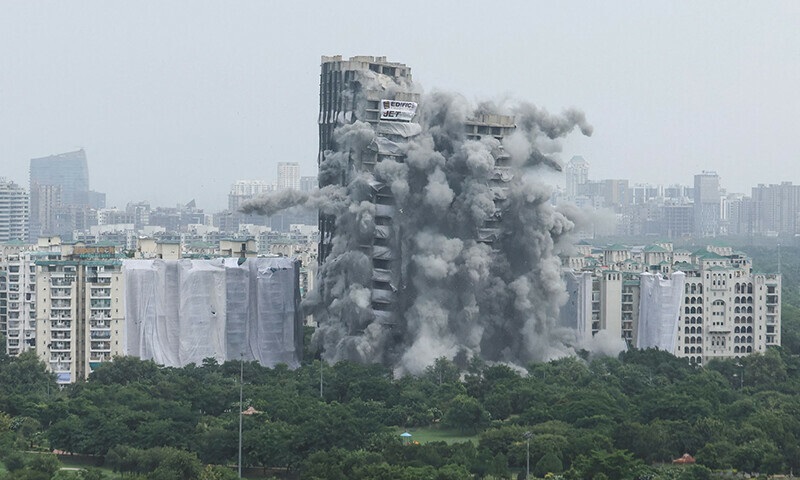
Noida- Nine years after a residents association went to court over the illegally built Supertech twin towers here, a series of controlled explosions reduced the 100-metre tall structures to a massive pile of rubble.
Apex (32 storeys) and Ceyane (29 storeys) were gone in seconds, in the carefully choreographed and meticulously executed demolition – the biggest such exercise in the country so far.
Local people watched from vantage points picked days in advance. Many others had travelled to Noida for what could be a once-in-a-lifetime spectacle, as 3,700 kilos of explosives bored into the pillars and walls of the two residential buildings went off in quick succession.
“It felt like structures of corruption were coming down,” said Purshotam Mishra, who watched the demolition ordered last year by the Supreme Court.
The apex court had pointed at the collusion between the builders and Noida Authority officials who let Supertech Ltd construct in the area where no buildings were to come up according to the original plans.
Just after 2.30 pm, the floors of the twin towers collapsed onto each other in a stack, which sat amid other complexes in sector 93A in Noida, an Uttar Pradesh city that adjoins New Delhi.
As the buildings went down, a cloud of dust rose obscuring their very final moments.
About 5,000 people from the adjoining Emerald Court and ATS Village societies had left their homes, hours before the demolition. Nearly 3,000 vehicles and about 200 pets were also taken out of harm’s way for the next several hours.
The dust settled a few minutes. Officials reported cracked windows and a broken boundary wall but no apparent structural damage to the high-rises next to the demolished towers.
The closest residential complex was just nine metres away and residents had complained that the illegal towers blocked their view.
A team from Edifice Engineering and South Africa’s Jet Demolitions the two companies that carried out the challenging task the Central Building Research Institute (CBRI) and the Noida Authority began a structural audit of the adjoining buildings.
Water sprinklers and anti-smog guns were activated at the site soon after the demolition to help contain the dust, an official said.
Officials said the demolition conducted by the waterfall implosion technique has left an estimated 35,000 cubic metres or 55,000 tonnes to 80,000 tonnes of debris, including concrete rubble, steel and iron bars that would take three months to be disposed of.
The Supreme Court had on August 31, 2021 ordered the demolition, upholding a verdict by the Allahabad High Court. It held that illegal construction has to be dealt with strictly to ensure compliance with the rule of law.
“The case has revealed a nefarious complicity of the planning authority in the violation by the developer of the provisions of law,” the top court had observed.
The Noida Authority, which had approved the building maps, oversaw the mega demolition exercise.
Now gone, the towers were to have 40 floors with 21 shops and 915 residential apartments with a fascinating view of the city.
Edifice Engineering hired South Africa’s Jet Demolitions for its expertise. The CBRI was appointed by the Supreme Court as the technical expert for the demolition project.
The top court ordered that Supertech would bear the cost of the demolition, which is estimated to be around Rs 20 crore.
In India, high-rise buildings have been demolished only once earlier through controlled explosions.
In Maradu municipality area of Kochi, Kerala, four 18 to 20-storey buildings were razed in 2020 for violating Coastal Regulation Zone norms. Edifice and Jet Demolitions had collaborated in Maradu as well.
Jet brought down the 108-metre-tall Bank of Lisbon building in Johannesburg, South Africa, in November 2019.
Follow this link to join our WhatsApp group: Join Now
Be Part of Quality Journalism |
Quality journalism takes a lot of time, money and hard work to produce and despite all the hardships we still do it. Our reporters and editors are working overtime in Kashmir and beyond to cover what you care about, break big stories, and expose injustices that can change lives. Today more people are reading Kashmir Observer than ever, but only a handful are paying while advertising revenues are falling fast. |
| ACT NOW |
| MONTHLY | Rs 100 | |
| YEARLY | Rs 1000 | |
| LIFETIME | Rs 10000 | |










